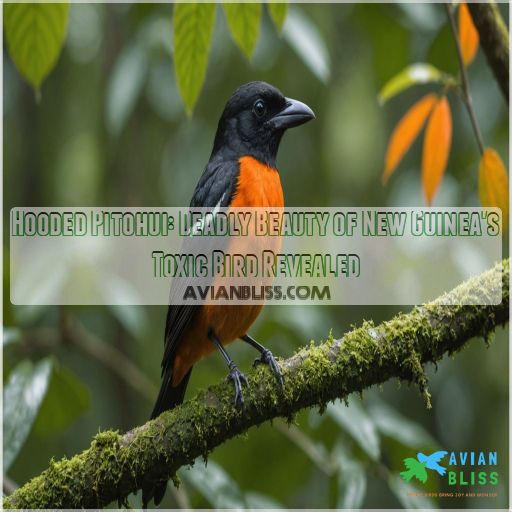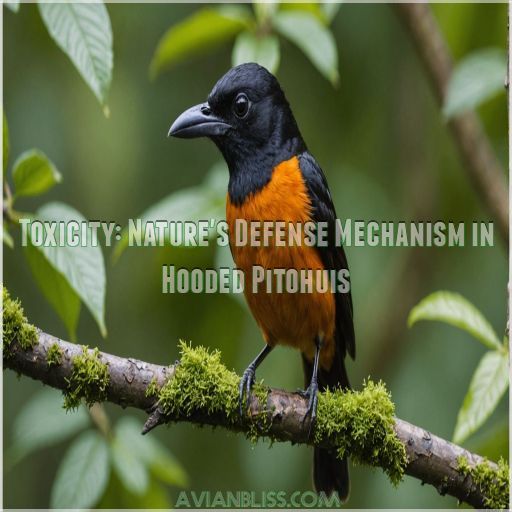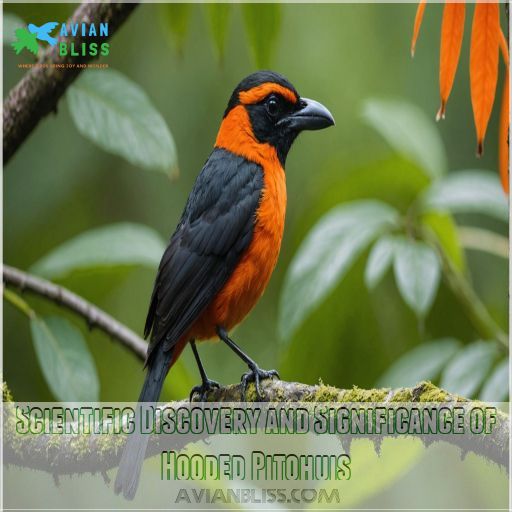This site is supported by our readers. We may earn a commission, at no cost to you, if you purchase through links.

This native of New Guinea has a secret weapon—batrachotoxins, the same potent poison found in poison dart frogs.
These toxic compounds lurk in its feathers, skin, and organs, causing numbness and tingling on contact.
The bird’s ability to tolerate this poison is thanks to evolutionary tricks and a diet that includes certain beetles, a key adaptation.
While it’s remarkable for redefining what people understand about birds, don’t worry—it won’t peck you into paralysis anytime soon.
Curious about its mimicry games?
Table Of Contents
- Key Takeaways
- Hooded Pitohui: Distinctive Features and Habitat
- Toxicity: Nature’s Defense Mechanism in Hooded Pitohuis
- Evolutionary Adaptations and Mimicry Strategies
- Scientific Discovery and Significance of Hooded Pitohuis
- Hooded Pitohui’s Ecological Role and Behavior
- Frequently Asked Questions (FAQs)
- What is a hooded pitohui?
- Is hooded pitohui poisonous?
- Where did hooded pitohui birds come from?
- Is a hooded pitohui a Whistler?
- What is unusual about the hooded pitohui?
- How does pitohui poison work?
- What poison does the hooded pitohui have?
- What does hooded pitohui mean in english?
- How do hooded pitohuis obtain their toxins?
- Are hooded pitohuis found outside New Guinea?
- What are the predators of hooded pitohuis?
- How do hooded pitohuis interact with other pitohui species?
- What sounds do hooded pitohuis make?
- Conclusion
Key Takeaways
- You’ll be amazed to learn that this striking New Guinea songbird packs a powerful punch—it’s one of the few known poisonous birds, with toxins lurking in its feathers, skin, and organs that can cause numbness and tingling on contact.
- The hooded pitohui’s toxicity is no joke—it gets its potent batrachotoxins from feasting on melyrid beetles, and has evolved clever "toxin sponges" to safely harbor these deadly compounds without self-poisoning.
- Beyond warding off predators, the hooded pitohui’s toxicity also serves as a built-in bug spray, helping it combat pesky parasites like lice. It’s a two-for-one defense system that showcases nature’s ingenious designs.
- The hooded pitohui’s discovery in 1989 was a real game-changer, sparking a paradigm shift in our understanding of bird biology and inspiring new research into the fascinating world of animal toxins. Who knew these vibrant songbirds were packing such a deadly secret?
Hooded Pitohui: Distinctive Features and Habitat
You’re about to meet one of nature’s most intriguing avian oddities: the hooded pitohui.
This striking bird, with its vibrant orange-brown body and jet-black wings, isn’t just a pretty face – it’s packing a toxic surprise that’ll make you think twice before getting too close.
Physical Appearance and Size
With striking plumage that’s hard to miss, the hooded pitohui is a true stunner of the bird world. You’ll be captivated by its:
- Orange belly contrasting with jet-black head and wings
- Dove-sized body, measuring 9 inches long
- Sharp, powerful black beak
- Fierce red eyes
- Erectable black head crest
Geographical Distribution in Indonesia-Papua New Guinea
You’ll find the hooded pitohui strutting its stuff across New Guinea’s lush landscapes.
This toxic trendsetter calls both Indonesia and Papua New Guinea home, making it a true island dweller .
Its distribution spans a variety of forest types, keeping predators on their toes.
Forest Dwelling Habits and Altitude Preferences
You’ll find Hooded Pitohuis thriving in New Guinea’s lush forests.
They’re adaptable, though, flitting between lowlands and mountains with ease.
These toxic beauties prefer the canopy, where they’re safer from predators and closer to their favorite snacks.
Talk about altitude adjustment!
Social Behavior and Flock Formation
You’ll find Hooded Pitohuis aren’t just solitary creatures.
They often form flocks, joining mixed-species hunting parties as leaders (Source).
These social butterflies of the forest team up with other birds, creating a dynamic group that’s safer and more efficient when foraging.
Vocalizations and Unique Calls
You’ve heard about the Hooded Pitohui’s social habits, but their vocalizations are equally fascinating.
These birds have a diverse repertoire of calls and songs that’ll make your ears perk up:
- Staccato calls for quick communication
- Bubbling calls that sound almost musical
- Melodious songs to establish territory
Toxicity: Nature’s Defense Mechanism in Hooded Pitohuis
You might think birds are harmless, but the hooded pitohui packs a surprising punch.
This unassuming New Guinea songbird harbors potent toxins in its feathers and skin, making it one of the few known poisonous birds in the world.
Batrachotoxins in Feathers, Skin, and Organs
You might be surprised to learn that hooded pitohuis pack a powerful punch.
These unassuming birds harbor batrachotoxins in their feathers, skin, and organs .
Nature’s clever defense mechanism makes these New Guinea natives a force to be reckoned with in the animal kingdom.
Symptoms of Toxin Exposure in Humans
While the hooded pitohui’s toxins protect it, they’re no joke for humans.
If you touch one, you might feel like you’ve grabbed a stinging nettle – numbness, tingling, and burning sensations are common .
In severe cases, paralysis or even death can occur .
Dietary Source of Toxins From Melyrid Beetles
Hooded pitohuis aren’t born toxic; they acquire their potent defense from their diet.
These crafty birds feast on melyrid beetles, which pack a powerful punch of batrachotoxins .
- Beetles accumulate toxins
- Birds consume beetles
- Toxins transfer to birds
- Birds become poisonous
Evolutionary Adaptations for Toxin Tolerance
Surprisingly, hooded pitohuis don’t rely on specially adapted sodium channels to tolerate toxins.
Instead, these crafty birds have evolved "toxin sponges" – proteins that mop up deadly compounds before they cause harm .
This clever adaptation allows them to safely harbor potent neurotoxins without self-poisoning.
Potential Functions of Toxicity in Survival
Nature’s chemical armor serves the hooded pitohui well. You’ll find its toxicity isn’t just for show—it’s a multifaceted survival tool.
- Keeps pesky parasites at bay
- Gives predators a nasty surprise
- Boosts its evolutionary street cred
- Turns it into a trendsetter for mimics
Evolutionary Adaptations and Mimicry Strategies
You might think the hooded pitohui’s striking orange and black plumage is just for show, but it’s actually a clever survival strategy.
This toxic bird’s appearance and chemical defenses have evolved in fascinating ways, influencing both its own species and others in its ecosystem.
Batesian Mimicry by Non-toxic Birds
You’ve seen the hooded pitohui’s toxic tricks, but what about its copycats?
Some birds play dress-up without the danger, fooling predators through Batesian mimicry.
Let’s explore this clever evolutionary strategy:
| Mimic | Model | Benefit |
|---|---|---|
| Non-toxic bird | Hooded pitohui | Predator avoidance |
| Viceroy butterfly | Monarch butterfly | Protection from birds |
| Harmless snake | Venomous coral snake | Survival advantage |
This sneaky game of pretend gives these creatures a fighting chance in the wild .
Mullerian Mimicry in Similarly Toxic Species
While Batesian mimicry involves non-toxic copycats, Müllerian mimicry‘s a different ball game.
It’s a ‘you scratch my back, I’ll scratch yours’ situation, benefiting all toxic players (Source).
In New Guinea, toxic birds like hooded pitohuis and blue-capped ifrits have evolved similar warning colors.
Visual Deterrence Against Predators
The hooded pitohui’s striking plumage isn’t just for show.
Its bold black and chestnut feathers scream "danger!" to would-be predators .
This visual deterrent, coupled with its potent toxins, gives the bird a serious survival edge in New Guinea’s forests .
Parasite Protection Through Toxicity
Beyond warding off predators, the hooded pitohui’s toxicity serves another clever purpose.
It’s a built-in bug spray!
Research shows these feathered chemists use their batrachotoxins to combat parasites like lice .
Talk about a two-for-one defense system!
Balance Between Toxin Production and Mimicry
You’ve seen how toxins shield pitohuis from parasites.
Now, let’s explore nature’s balancing act.
These birds juggle toxin production with mimicry, weighing costs and benefits.
It’s a delicate dance between chemical defenses and visual trickery, all to keep predators at bay .
Scientific Discovery and Significance of Hooded Pitohuis
You’re about to uncover the fascinating tale of how scientists stumbled upon one of nature’s most unexpected toxins.
The discovery of the hooded pitohui’s deadly secret shocked researchers but also reshaped our understanding of avian biology and sparked a new era of toxin research in the animal kingdom.
Jack Dumbacher’s Accidental Discovery in 1989
Ever wondered how scientists stumble upon nature’s secrets?
In 1989, Jack Dumbacher’s hands burned while freeing hooded pitohuis from his mist nets in Papua New Guinea.
Little did he know, he’d just encountered the world’s first known poisonous bird .
Identification of Batrachotoxins by John Daly
While Dumbacher stumbled upon the pitohui’s toxicity, it was John Daly who unraveled its secrets.
Using his expertise in frog toxins, Daly identified the same batrachotoxins in the bird’s feathers, marking a groundbreaking moment in avian research .
Comparison With Poison Dart Frogs’ Toxicity
The hooded pitohui’s toxicity mirrors the spectrum seen in poison dart frogs, displaying evolutionary convergence.
Both acquire their deadly batrachotoxins by consuming melyrid beetles, showcasing nature’s defense mechanisms and intricate mimicry patterns in their survival strategies .
Impact on Traditional Understanding of Bird Biology
Drawing comparisons with poison dart frogs, the hooded pitohui redefined bird biology, sparking an evolutionary surprise:
- Paradigm shift: Birds can be poisonous.
- Complex diet-toxicity link.
- Rethinking animal defenses.
- Inspires scientific breakthroughs and new discoveries.
Talk about a plot twist!
Ongoing Research Into Animal Kingdom Toxins
Exploring animal toxins like the Hooded Pitohui’s, you’re diving into evolution’s secret plays.
Toxins spark fascinating research, revealing insights into venomous birds, defense strategies, and potential applications.
It’s a thrilling quest that intertwines nature’s cunning designs with scientific curiosity .
Hooded Pitohui’s Ecological Role and Behavior
The hooded pitohui’s ecological role is as fascinating as its deadly toxicity.
From leading mixed-species hunting parties to foraging on a diverse diet, this remarkable bird is a key player in the forests of New Guinea.
Mixed Species Hunting Party Leadership
Hooded Pitohuis exhibit intriguing leadership qualities within their hunting parties, composed of multiple bird species.
While foraging, they frequently initiate the pursuit of prey, rallying other species to follow.
This coordinated teamwork enhances their chances of success and safety, demonstrating how leadership skills contribute to survival and ecological balance.
Diet Composition and Foraging Strategies
These resourceful birds show quite the taste for variety. Their diet reflects beetle preference and prey selection that dramatically influence their habitat.
Keep an eye on:
- Juicy berries
- Insects like beetles
- Clever foraging techniques adjust for food competition
- Habitat influence on dietary choices .
Interactions With Other Forest Inhabitants
You might think these colorful characters enjoy solitude, but hooded pitohuis play a key role in their jungle community.
Mixed-species flocks contribute to predator-prey dynamics and interspecific communication.
Their toxicity even makes them less appetizing, promoting mutualistic interactions within their feathered neighborhood (Source).
Conservation Status and Population Trends
Amid forest encounters with fellow creatures, the hooded pitohui’s stability shines through.
Despite habitat loss and human impact, its population size remains stable, fashioning it as a beacon of survival.
Listed as Least Concern, conservation efforts focus on understanding this enigmatic bird’s ecological role in light of pest control.
Frequently Asked Questions (FAQs)
What is a hooded pitohui?
The hooded pitohui is one of the few known poisonous birds, secreting a powerful neurotoxin called batrachotoxin that it gets from the beetles it eats.
This unique adaptation helps ward off predators and parasites.
Is hooded pitohui poisonous?
Hooded pitohuis are indeed poisonous!
By munching on toxic Choresine beetles in New Guinea, they accumulate batrachotoxins in their feathers and skin.
Touching them might make your hands tingle or burn like a hot pepper surprise .
Where did hooded pitohui birds come from?
Did you know that the hooded pitohui hails from the lush rainforests of New Guinea?
It sports vibrant plumage and packs a surprising punch with its venomous feathers, offering a wild twist on avian evolution .
Is a hooded pitohui a Whistler?
You’re wondering about bird families, and it’s intriguing!
While the hooded pitohui isn’t a whistler, some related toxic birds are.
They’re in different families despite shared traits like glorious plumage and potent defenses .
What is unusual about the hooded pitohui?
Imagine a bird carrying a secret weapon in its feathers—a neurotoxic cocktail so fierce it deters predators and parasites alike.
This pitohui gets its poison from munching on toxic beetles, turning itself into nature’s daring daredevil .
How does pitohui poison work?
Pitohui poison, containing batrachotoxin, disrupts nerve function by binding to sodium channels, holding them open.
This causes excessive nerve signaling, leading to paralysis and possible death—a toxic cocktail that really packs a punch .
What poison does the hooded pitohui have?
The hooded pitohui carries batrachotoxins in its feathers, potent neurotoxic alkaloids that can cause paralysis or death.
It absorbs these toxins from its diet of melyrid beetles, creating a brilliant yet dangerous natural defense system .
What does hooded pitohui mean in english?
The term "hooded pitohui" refers to a species of poisonous bird found in New Guinea.
It gets its name from its distinctive black hood-like plumage.
It belongs to the oriole family.
How do hooded pitohuis obtain their toxins?
Imagine a bird stealing its powers from beetles!
Hooded pitohuis pick up batrachotoxins by munching on certain melrid beetles.
This chemical defense helps them scare off predators, turning these feathery singers into nature’s own little warriors .
Are hooded pitohuis found outside New Guinea?
Hooded pitohuis are exclusively native to the tropical rainforests and jungles of New Guinea.
They haven’t spread their wings beyond this island, likely enjoying their enigmatic status as one of Earth’s few poisonous birds .
What are the predators of hooded pitohuis?
You might think predators would steer clear due to their bright warning colors and potent toxins.
Snakes and other potential predators quickly learn to avoid them, as the toxins can be extremely harmful if ingested .
How do hooded pitohuis interact with other pitohui species?
Hooded pitohuis interact with other pitohui species through gene flow, occasionally mating with southern variable pitohuis.
This interaction facilitates the sharing of alleles for toxin resistance and coloration.
This sharing of alleles contributes to their mimicry defense strategy .
What sounds do hooded pitohuis make?
Listen to the lively and varied calls and songs of these elusive birds.
From staccato notes to bubbling melodies, they express their presence in New Guinea’s forests, each note carrying a story of the wild .
Conclusion
Imagine stumbling upon New Guinea’s vibrant forest and meeting a seemingly unassuming bird, like a Hawaiian red-headed bird.
The hooded pitohui, with its dazzling plumage, isn’t just eye-catching—it’s a proof of nature’s clever strategies.
This songbird wields batrachotoxins not just for defense but also for a wild mimicry game, keeping predators guessing by looking toxic like others .
These striking features make it a fascinating subject of scientific intrigue and a reminder of nature’s unpredictable wonders.








